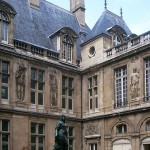
There are a lot of styles you will see in Paris architecture. However, it’s significant to point out that very few structures were built in one particular method. These enormous structures of Paris architecture may look centuries to complete, where plans were modified and a lot were changed, but these were still put into completion at present.
Romanesque architects got their encouragement based on olden Rome and focused building huge church aisle with extraordinary width. St. Germain-de-Pres is a good resemblance of few Romanesque styles that remains in Paris. The whole building was Romanesque, but as time pass by, the time builders change some plans and resulted to a early Gothic style with spiky arches.
Gothic engineering progress unconstrained church architecture from the weighty, dense wall structures of Romanesque style. This happened in the 12th century where the dim, subdued, relatively plain Romanesque interior that forced the visions of the people straight to the altar. The new Gothic interior lured the worshippers’ stare upward to high ceilings filled with graceful light. On the other hand, the Romanesque exteriors were positioned by elegant buttresses and spires. Perhaps, the best illustration of Gothic church architecture in the world is Notre-Dame Cathedral.
In architecture, as in painting, the Renaissance came from Italy and took some time to coalesce. And, as in painting, its rules stressed proportion, order, classical inspiration, and precision, resulting in unified, balanced structures. One example is the 1544 Hotel Carnavalet, a Renaissance mansion, is the only 16th century hotel left in Paris. It contains the Musee Carnavalet, a museum devoted to the history of Paris and the French Revolution.
From the mid 17th century, France took the fundamental of Renaissance classicism even further, finding inspiration in the classic era. During the reign of Louis XIV, art and architecture were submissive to political ends. Buildings were grandiose and severely ordered on the Versailles model.
Paris architecture style in 19th century was diverse, beginning in a severe classical mode and ending with something of an identity crisis. During the reign of Emperor Napoleon III, classicism was reinterpreted in an ornate, dramatic mode. Urban planning was the architectural rage, and Paris became a city of wide boulevards courtesy of Baron Georges-Eugene Haussmann, commissioned by Napoleon III in 1852 to redesign the city. Paris owes much of its remarkably unified look to Haussmann.
The ravages of war stalled the progress of French architecture for a number of decades, but the latter half of the 20th century was to see some the most daring Paris architecture projects in French history and certainly some of the most controversial. It has taken decades for structure such as the Centre Pompidou or the Louvre’s glass pyramids to become accepted by most Parisians, but now they are a well-loved part of the skyline.
The face of Paris architecture is ever changing. The new era has already seen the arrival of the Musee de Qui Branly, an impressive, angular structure designed by Jean Nouvel, whose bright colors and clever use of vegetation is a flagship for 21st century Paris architecture within the city center.
Paris architecture was one of the best artworks that is highly respected all over the world. Despite the ups and downs, it still managed to develop through time.

I for one, am a fan of the gothic architecture. Most of the buildings which were inspired by the Gothic era are usually grand and have a dark yet romantic look to it. I am always left in awe by the use of stained glasses, high ceilings, and just the intricate design of the whole edifice. My favorite Goth inspired building in Paris would definitely have to be the Chartres Cathedral.
Even though Paris undergone different eras of Architecture, some are relentlessly different from the other, some has similarities which complements each other and some who evolve from the idea of the previous era, it remained organize with its building structures. The theme remained in every building which is very impressive. The revolutionizing of the art and style of these structures did not alter its meaning and memories. The different Paris architecture even help Paris develop from time to time until this modern outlook of Paris.